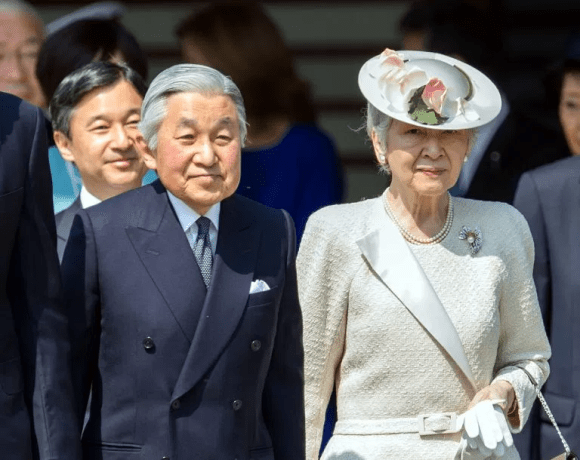
Emperor Akihito will likely be sitting on the Chrysanthemum Throne a little longer than most expected.
Earlier this year, 83-year-old Emperor Akihito made known his intention to abdicate, stepping down from the largely ceremonial position he has held since 1989. Akihito will become the first emperor to abdicate the throne since Emperor Kokaku, who did so in in 1817, making him also the first Japanese monarch to abdicate since Japan’s feudal era ended.
Previously, there was no legal framework for such a transition (Akihito become emperor upon the death of his father, Hirohito), and the unprecedented-in-modern-times move required the drafting of new legislation governing the handover. Until recently, it was thought that Akihito would step down on April 1, 2019, which would coincide with the beginning of the Japanese fiscal year. However, it now seems like the emperor’s abdication will be pushed back.
The April 1 date falls close to scheduled nationwide local political elections, and some, including Prime Minister Shinzo Abe, feel it would be unseemly to mark the beginning of a new emperor’s era with the likely discord and disruptions that accompany and often linger after political contests. Because of that, an alternate abdication date of May 1, 2019 has been proposed.
The Imperial Council Household has announced plans to meet on the morning of December 1 for a conference in which it will decide between the April 1 and May 1 dates, though most political observers are predicting that the latter date will be chosen. In either case, though, it looks certain that Akihito’s successor, his son Naruhito, will ascend to the throne before the summer of 2019, thus officially bringing and end to the Heisei imperial era 30 years after its beginning.
Sources: Nihon Keizai Shimbun via Jin, Sankei News
Top image: Wikimedia Commons/William Ng

 Japanese Emperor abdication date revealed by government officials in new report
Japanese Emperor abdication date revealed by government officials in new report Japanese Emperor’s abdication date set, end of Heisei era now officially on the horizon
Japanese Emperor’s abdication date set, end of Heisei era now officially on the horizon The one-year countdown officially begins for the end of the Heisei Era
The one-year countdown officially begins for the end of the Heisei Era J-Pop singer to perform song written and composed by the emperor and empress at upcoming ceremony
J-Pop singer to perform song written and composed by the emperor and empress at upcoming ceremony Emperor Akihito hints at abdication of throne in new video message
Emperor Akihito hints at abdication of throne in new video message McDonald’s new Happy Meals offer up cute and practical Sanrio lifestyle goods
McDonald’s new Happy Meals offer up cute and practical Sanrio lifestyle goods All-you-can-drink Starbucks and amazing views part of Tokyo’s new 170 meter-high sky lounge
All-you-can-drink Starbucks and amazing views part of Tokyo’s new 170 meter-high sky lounge Beautiful Sailor Moon manhole cover coasters being given out for free by Tokyo tourist center
Beautiful Sailor Moon manhole cover coasters being given out for free by Tokyo tourist center More foreign tourists than ever before in history visited Japan last month
More foreign tourists than ever before in history visited Japan last month Studio Ghibli glasses cases let anime characters keep an eye on your spectacles
Studio Ghibli glasses cases let anime characters keep an eye on your spectacles Is the new Shinkansen Train Desk ticket worth it?
Is the new Shinkansen Train Desk ticket worth it? Arrest proves a common Japanese saying about apologies and police
Arrest proves a common Japanese saying about apologies and police Starbucks reopens at Shibuya Scramble Crossing with new look and design concept
Starbucks reopens at Shibuya Scramble Crossing with new look and design concept Mister Donut ready to make hojicha dreams come true in latest collab with Kyoto tea merchant
Mister Donut ready to make hojicha dreams come true in latest collab with Kyoto tea merchant The 2023 Sanrio character popularity ranking results revealed
The 2023 Sanrio character popularity ranking results revealed Disney princesses get official manga makeovers for Manga Princess Cafe opening in Tokyo
Disney princesses get official manga makeovers for Manga Princess Cafe opening in Tokyo Beautiful new Final Fantasy T-shirt collection on the way from Uniqlo【Photos】
Beautiful new Final Fantasy T-shirt collection on the way from Uniqlo【Photos】 Foreign English teachers in Japan pick their favorite Japanese-language phrases【Survey】
Foreign English teachers in Japan pick their favorite Japanese-language phrases【Survey】 Japanese convenience store packs a whole bento into an onigiri rice ball
Japanese convenience store packs a whole bento into an onigiri rice ball We try out “Chan Ramen”, an underground type of ramen popular in the ramen community
We try out “Chan Ramen”, an underground type of ramen popular in the ramen community Studio Ghibli releases Kiki’s Delivery Service chocolate cake pouches in Japan
Studio Ghibli releases Kiki’s Delivery Service chocolate cake pouches in Japan Japan’s bone-breaking and record-breaking roller coaster is permanently shutting down
Japan’s bone-breaking and record-breaking roller coaster is permanently shutting down New definition of “Japanese whiskey” goes into effect to prevent fakes from fooling overseas buyers
New definition of “Japanese whiskey” goes into effect to prevent fakes from fooling overseas buyers Our Japanese reporter visits Costco in the U.S., finds super American and very Japanese things
Our Japanese reporter visits Costco in the U.S., finds super American and very Japanese things Studio Ghibli unveils Mother’s Day gift set that captures the love in My Neighbour Totoro
Studio Ghibli unveils Mother’s Day gift set that captures the love in My Neighbour Totoro Foreign passenger shoves conductor on one of the last full runs for Japan’s Thunderbird train
Foreign passenger shoves conductor on one of the last full runs for Japan’s Thunderbird train Domino’s Japan now sells…pizza ears?
Domino’s Japan now sells…pizza ears? New Japanese KitKat flavour stars Sanrio characters, including Hello Kitty
New Japanese KitKat flavour stars Sanrio characters, including Hello Kitty Kyoto creates new for-tourist buses to address overtourism with higher prices, faster rides
Kyoto creates new for-tourist buses to address overtourism with higher prices, faster rides Sales of Japan’s most convenient train ticket/shopping payment cards suspended indefinitely
Sales of Japan’s most convenient train ticket/shopping payment cards suspended indefinitely Sold-out Studio Ghibli desktop humidifiers are back so Totoro can help you through the dry season
Sold-out Studio Ghibli desktop humidifiers are back so Totoro can help you through the dry season Japanese government to make first change to romanization spelling rules since the 1950s
Japanese government to make first change to romanization spelling rules since the 1950s Ghibli founders Toshio Suzuki and Hayao Miyazaki contribute to Japanese whisky Totoro label design
Ghibli founders Toshio Suzuki and Hayao Miyazaki contribute to Japanese whisky Totoro label design Doraemon found buried at sea as scene from 1993 anime becomes real life【Photos】
Doraemon found buried at sea as scene from 1993 anime becomes real life【Photos】 Tokyo’s most famous Starbucks is closed
Tokyo’s most famous Starbucks is closed One Piece characters’ nationalities revealed, but fans have mixed opinions
One Piece characters’ nationalities revealed, but fans have mixed opinions We asked a Uniqlo employee what four things we should buy and their suggestions didn’t disappoint
We asked a Uniqlo employee what four things we should buy and their suggestions didn’t disappoint Princesses, fruits, and blacksmiths: Study reveals the 30 most unusual family names in Japan
Princesses, fruits, and blacksmiths: Study reveals the 30 most unusual family names in Japan Japan announces new era name, Reiwa, but what does it mean and why was it chosen?
Japan announces new era name, Reiwa, but what does it mean and why was it chosen? Confusion as Imperial official denies rumors that Japan’s Emperor Akihito plans to step down
Confusion as Imperial official denies rumors that Japan’s Emperor Akihito plans to step down End of the Heisei Era: Japanese government to announce new era name on 1 April
End of the Heisei Era: Japanese government to announce new era name on 1 April Twitter users say Japanese Prime Minister’s name is hiding in the kanji for Japan’s new era name
Twitter users say Japanese Prime Minister’s name is hiding in the kanji for Japan’s new era name Christian groups in Japan criticize emperor’s ascension ceremony as violation of constitution
Christian groups in Japan criticize emperor’s ascension ceremony as violation of constitution Japanese government proposes driver’s license change to make them easier for foreigners to read
Japanese government proposes driver’s license change to make them easier for foreigners to read Donald Trump will probably be the first foreign leader to meet with Japan’s new emperor
Donald Trump will probably be the first foreign leader to meet with Japan’s new emperor Pokémon GO player claims his in-game snapshot shows Japan’s new emperor and Pikachu together
Pokémon GO player claims his in-game snapshot shows Japan’s new emperor and Pikachu together Prime Minster Abe tells Trump that imperial succession is “100 times bigger” than the Super Bowl
Prime Minster Abe tells Trump that imperial succession is “100 times bigger” than the Super Bowl Reiwa era gets anthropomorphised into a Japanese anime girl by otaku artists
Reiwa era gets anthropomorphised into a Japanese anime girl by otaku artists Japanese government to outlaw carrying unbound knives on trains starting next year
Japanese government to outlaw carrying unbound knives on trains starting next year “Disaster”: 2018 Kanji of the Year unveiled by Buddhist monk at Kiyomizudera temple in Kyoto
“Disaster”: 2018 Kanji of the Year unveiled by Buddhist monk at Kiyomizudera temple in Kyoto How do you say “Happy New Era” in Japanese?
How do you say “Happy New Era” in Japanese? Japanese newspapers announcing the new “Reiwa” era are being auctioned online for high prices
Japanese newspapers announcing the new “Reiwa” era are being auctioned online for high prices Man jumps off bridge in Osaka to celebrate Heisei era’s end, hits something other than water【Vid】
Man jumps off bridge in Osaka to celebrate Heisei era’s end, hits something other than water【Vid】 Four new era names the Japanese government rejected before deciding on Reiwa
Four new era names the Japanese government rejected before deciding on Reiwa
Leave a Reply